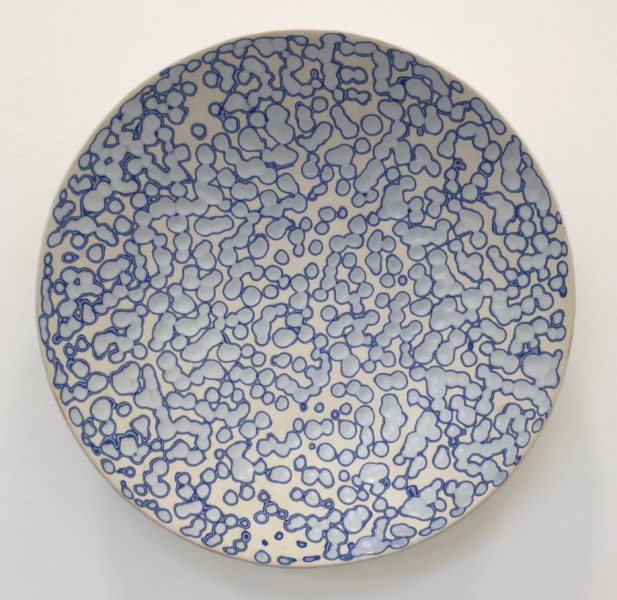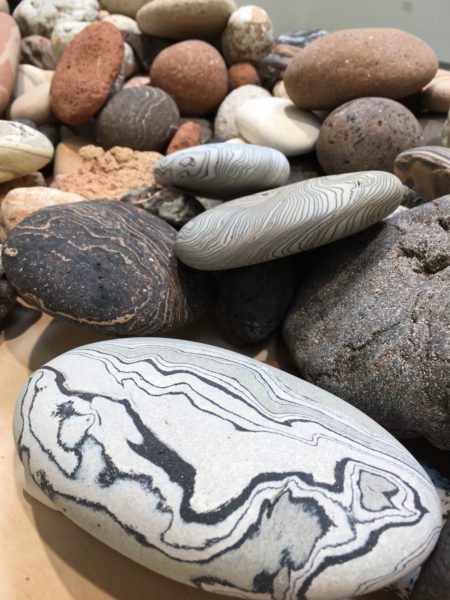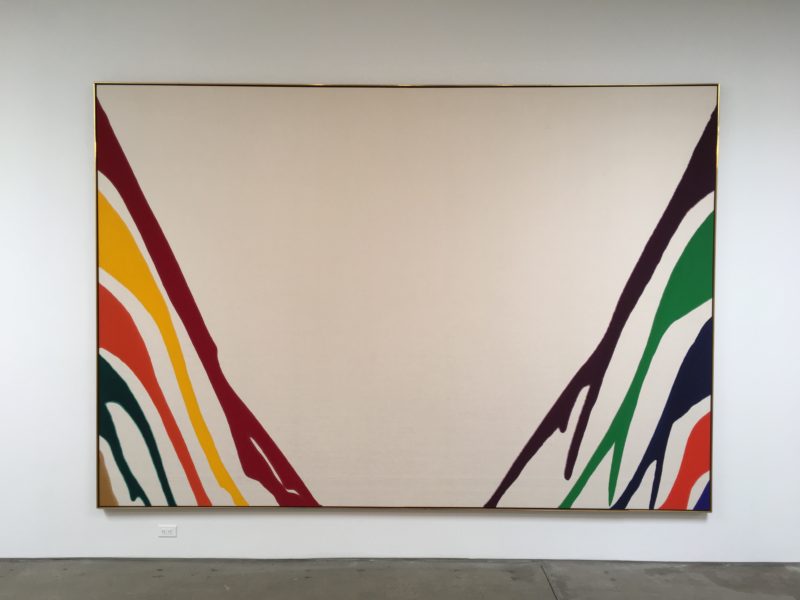Brad Miller: Stones & Object Relations Theory is on exhibit through August 19th at Edward Cella Art and Architecture in Culver City. The show presents Miller’s latest ceramic wall sculptures, abstract ceramic stonework and paintings. The first thing you notice about artist’s work is the relationship to nature and life systems. They are not just decorative sculpture; the bowls have intricate repeating patterns of cell structure, biology and what appears to be anatomical structure in the paintings. The work is a combination of abstract expressionism and realism that captures the activity of life.
Miller’s inspiration comes from growing up in Portland and gaining exposure to the environment and organic systems via local art collections and exhibitions in addition to texts such as Art Forms in Nature (originally published in 1899!) by Ernst Haeckel and Darcy Thompson’s On Growth and Form.
The bowl sculptures are stunning, from a distance a number seem to have the recognizable blue and white patterns associated with Delft stone wear or Chinese porcelain. Upon closer inspection you’ll discover what appears to be cellular division, cell wall rupture, bacteria on a petri dish and possibly interconnected Benzene rings. A few look like outright battles featuring white blood cells attacking would be invaders; you can decide who’s winning the war.

The complex designs are not painted on the sculptures, instead, up to six alternating layers of colored slip are first applied to the exterior. Then after glazing and firing the pieces are excavated by grinding, etching or boring to create the final works as seen in this video by the artist on Instagram. The paintings on the gallery wall mirror the anatomical theme of the ceramics. The acrylic works seem to be almost three-dimensional MRIs of the brain from different vantage points, although Miller tells me they are based on simple organic organisms. His painting technique is painstakingly precise; the images have perfect symmetry and a true sense of 3D depth. Thankfully, none of them show evidence of disease.

In the center of the gallery space is a table with hundreds of Miller’s “rocks”. When I first visited his studio in Venice, I actually though he had taken river rocks and painted them with array of intricate patterns. Then I heard him talking about glazing and firing and realized that he actually created these works of art from scratch! They are all hand-formed, glazed, fired and tumbled to achieve the desired outcome. Don’t try this yourself at home – because one air bubble and you’ll blow up everything in the kiln. You can pick out individual rocks from the larger sculpture to form you own unique piece.

Honor Fraser Gallery’s exhibition of Morris Louis paintings has been extended through August 30th, 2017 . The survey features nine large museum quality works taking up the majority of the gallery space. Louis is well known for being one of the earliest Color Field painters (e.g. Rothko, Frankenthaler, Newman, Noland, Kelly etc.); his works often feature large, bold washes of color spread across the canvas. He is perhaps most easily recognized by the public in museums for his “unfurled” paintings that feature vivid parallel lines of colors angled toward one another from opposite ends of the canvas. The majority of those works were executed between 1960 and1961; they leave much of the canvas raw or blank. The exhibit also displays a number of the “Veil” paintings done in the mid to late 1950s. This series tends to favor more muted colors with the paint taking up the majority of the canvas surface and has many more stained layers. Louis died at age of 50 from lung cancer attributed to vapors from painting; nevertheless, he managed to produce 650 canvases. The exhibition is a great way to see a museum level exhibit without waiting in lines or paying for parking.
Gallery Captions:
- Brad Miller, Untitled (Stones), 2017, Ceramic, hand formed and tumbled, variable dimensions
- Brad Miller, 2017-28 2017, Porcelain, 19” x 19” x 3.25”
- Morris Louis: “Delta Epsilon”, 1960, Magna on Canvas, 104” x 151”.







